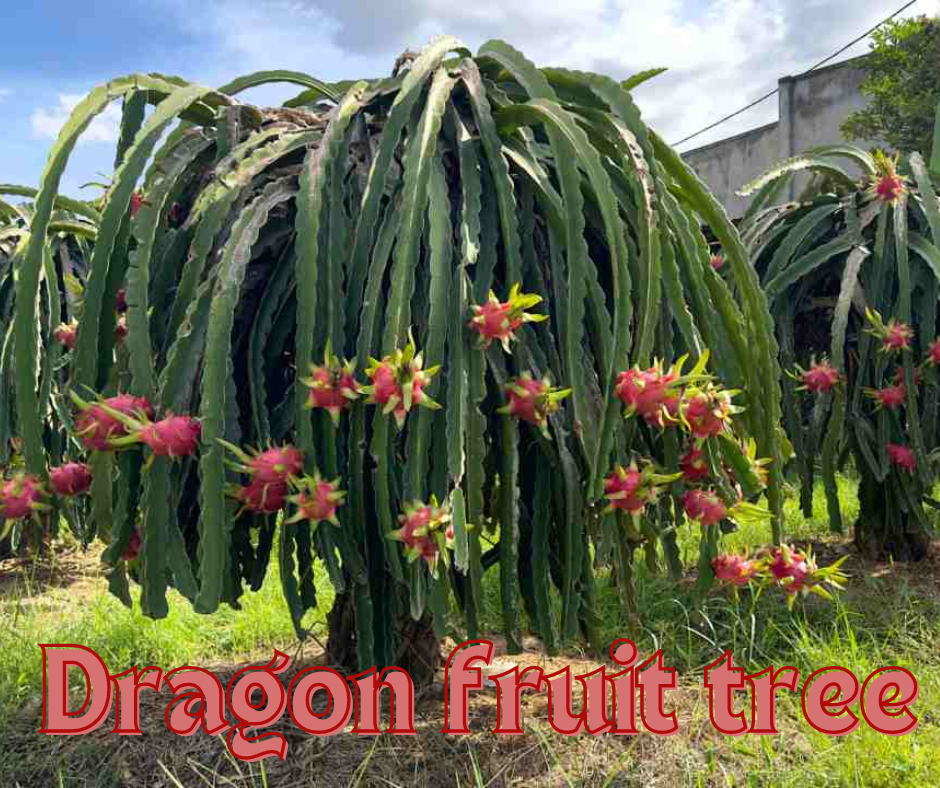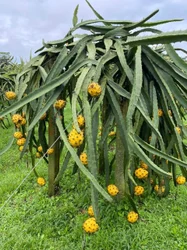Introduction
Few species in the world of exotic flora touch the imagination as deeply as the dragon fruit tree. This botanical wonder, renowned for its alluring beauty, delicious fruits, and adaptability, is a monument to the creativity of nature. In this journey, we travel through the many characteristics of the dragon fruit tree, learning its secrets from the ground up to the tall sky.

History and Definitions
The dragon fruit tree originated in the dry parts of Central America, where it grows well in warm climates with sandy soils. The genus Hylocereus, also known by its formal name, contains numerous species that add to the variety of colors present in dragon fruit varieties. The common name of the dragon fruit tree is derived from the colorful, dragon-like look of its fruits, which makes its name fascinating.
Dragon fruit tree price
Growing dragon fruit is a profitable activity for those who enjoy farming because it is a viable business. The age, variety, and growing techniques of the dragon fruit tree are some of the variables that affect its pricing. The growing popularity of dragon fruit makes it essential for anyone thinking about getting into this horticultural field to comprehend the workings of the industry.
Yellow dragon fruit tree

The yellow dragon fruit tree is unique among the several species in that it has a skin tone that is golden in colour and a tasting profile that is sweet and acidic. A careful strategy is needed to cultivate yellow dragon fruit, taking into account variables like temperature, water availability, and the acidity of the soil. These trees’ golden wealth has gained popularity in both domestic and foreign marketplaces.
Dragon fruit tree in India
Growing dragon fruit trees has become more and more popular in recent years, becoming a welcome addition to gardens across the globe. There has been a rise in interest in growing dragon fruit trees in India because of its varied agroclimatic zones. In India, the dragon fruit tree is becoming more and more well-known for its decorative qualities as well as the potential for profit that its fruits hold.
Dragon fruit tree name
Scientifically speaking, the tree of dragon fruit belongs to the genus Hylocereus and comes in a variety of kinds and cultivars, each with its own distinct qualities. Here is a list of some famous names for dragon fruit trees:
- Hylocereus undatus: This species is famous for its bright pink or red skin and sweet, slightly flavored pulp. It is also called the white-fleshed dragon fruit, or pitaya blanca.
- Hylocereus costaricensis: This species, which is sometimes referred to as the red-fleshed dragon fruit or Costa Rican pitaya, has a deep red interior and tastes slightly more acidic than its white-fleshed relative.
- Hylocereus megalanthus: This species, also known as pitaya amarilla or yellow dragon fruit, is distinguished by its vivid yellow skin and tart, sweet flavour.
- Hylocereus polyrhizus: This species, also known as the red dragon fruit or Vietnamese dragon fruit, stands out for its rich magenta or scarlet flesh, which contrasts sharply with its green or yellow exterior.
- Hylocereus triangularis: This species, also called the triangular pitaya or red-fleshed pitaya, has flesh that is a vivid magenta color and stems that are shaped like triangles.
- Hylocereus ocamponis: This dragon fruit variation, often known as the strawberry pear, differs from other species with its unique cylindrical shape and sweeter flavour.
- Hylocereus stenopterus: This species, which is native to Central America, is sometimes called the golden dragon fruit or yellow pitaya because of its yellow skin and white flesh.
- Hylocereus guatemalensis: Often called the yellow dragon fruit or Guatemalan pitaya, this species is prized for its yellow skin and sweet flavour.
- Hylocereus monacanthus: Known by many names, including pitaya amarilla or yellow pitaya, this species is distinguished by its yellow skin and slightly sweet flavour.
- Hylocereus purpusii: Known for its decorative attributes, this type of dragon fruit is also known as the pitaya de mayo and has beautiful, night-blooming blossoms.
It’s crucial to remember that there are many cultivars within each species, each with unique qualities and that their names may differ depending on the locality. The many taxa of the tree of dragon fruit increase the allure of growing these unusual and breathtakingly beautiful plants.
Dragon fruit tree flower

The beautiful way the dragon fruit flowers are arranged is what makes it so appealing. The bloom of the dragon fruit tree opens at night, revealing its petals against the backdrop of the moon. The fleeting beauty of these flowers adds to the mystique surrounding the nurturing process. An essential phase of the dragon fruit tree’s life cycle is the intricate dance of pollination, which frequently involves sleeping creatures.
Dragon fruit tree plantation
A careful balance of environmental elements, soil composition, and diligent maintenance are necessary for the establishment of a successful dragon fruit plantation. In the early phases of dragon fruit cultivation, careful site selection is necessary, taking into account elements like sunlight exposure, soil drainage, and wind protection. The young trees, referred to as “pups,” receive careful attention until they develop into healthy, fruit-bearing adults.
Dragon Fruit Tree Height
Similar to how each instrument in a symphony has a distinct purpose, the height of the dragon fruit trees adds to the overall harmony of a plantation’s visual aesthetic. Usually growing to a height of five to ten feet, these tree-climbing marvels have thin, divided stems that sprout wide branches. The stems’ uniform arrangement helps with effective cultivating techniques in addition to improving visual appeal.
Dragon fruit tree lifespan
The tree of dragon fruit, which is a member of the Hylocereus genus, has an amazing life expectancy of more than twenty years when grown in the right conditions. Its life cycle begins with seed germination or cutting propagation, and it advances through early, robust vegetative development. In this phase, a strong root system and a branching network with sound structural integrity are established. The tree’s long lifespan is mostly due to its tolerance to a variety of settings, including tropical and desert climes. The plant’s tenacity in the face of environmental challenges, such as temperature changes and pest resistance, demonstrates its resilience.
The tree’s longevity is mostly dependent on ideal circumstances, which include plenty of sunshine exposure, well-draining soil, and shelter from severe weather occurrences. The growth stages of the dragon fruit tree, from establishment to maturity, tell a rich story of the resilience of plants. An extended life is a result of regular care techniques, such as trimming, for both aesthetic and health reasons. Even with problems like illnesses and pests, risks can be reduced with careful observation and quick action.
The lengthy lifespan of the tree of dragon fruit has financial ramifications, especially for growers who engage in commercial production. A consistent output over time ensures a supply of dragon fruit, which increases the orchard’s economic viability. The dragon fruit tree’s longevity is a monument to its enduring brilliance in the vast fabric of nature. Its ability to flourish and bear fruit over time has captivated both admirers and cultivators.
In Conclusion:
Nature creates a brilliant masterpiece in the complex weaving of dragon fruit farming, from the sprouting of seeds to the harvesting of luscious fruits. The dragon fruit tree becomes a representation of strength, flexibility, and the peaceful coexistence of human development and the elements. The appeal of this botanical miracle transforms into a profound appreciation for the delights that nature, in its infinite wisdom, showers upon us as we travel the different landscapes of dragon fruit plantations.
